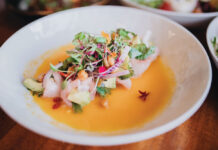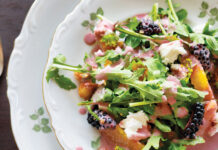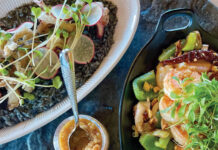Story by Shannon Wianecki | Photography by Nina Lee
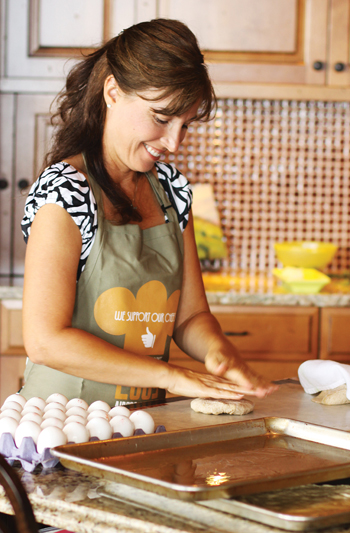 Just in time for the holidays, Chef Tylun Pang has dished up a new cookbook—a culturally rich and satisfying meal itself. The celebrated executive chef of the Fairmont Kea Lani draws recipes from plantation roots and professional contacts. Even beloved, bygone Maui restaurants are remembered. What Maui Likes to Eat blends everything from Toda’s hamburgers to Holy Ghost Church’s Portuguese sweet bread into a seamless presentation of uniquely Maui cuisine.
Just in time for the holidays, Chef Tylun Pang has dished up a new cookbook—a culturally rich and satisfying meal itself. The celebrated executive chef of the Fairmont Kea Lani draws recipes from plantation roots and professional contacts. Even beloved, bygone Maui restaurants are remembered. What Maui Likes to Eat blends everything from Toda’s hamburgers to Holy Ghost Church’s Portuguese sweet bread into a seamless presentation of uniquely Maui cuisine.
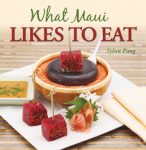 For this year’s episode of MNKO’s Test Kitchen, a few friends and I dove into an advance copy of Pang’s book, scheduled for release November 1st. As we gathered ingredients and spent the day cooking, we embodied the chef’s introductory comments: “Maui cooking is about people. The more people pitch in, the better the food tastes!”
For this year’s episode of MNKO’s Test Kitchen, a few friends and I dove into an advance copy of Pang’s book, scheduled for release November 1st. As we gathered ingredients and spent the day cooking, we embodied the chef’s introductory comments: “Maui cooking is about people. The more people pitch in, the better the food tastes!”
If you’d like to duplicate our adventures, find the recipes here (or click the name of each dish to see its recipe).
Kula Onion and Surfing Goat Dairy Flatbread
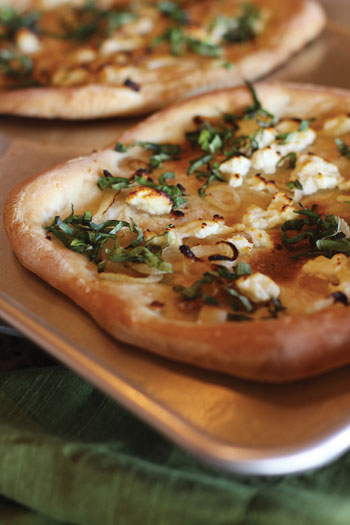 Our cooking marathon started at 11 a.m., so I knew we’d need a snack right away. Since Dania, my sous chef for the day, advocates “eating local,” we chose a recipe from the cookbook’s “Grown on Maui” section. This simple yet sophisticated flatbread pays homage to Upcountry farmers.
Our cooking marathon started at 11 a.m., so I knew we’d need a snack right away. Since Dania, my sous chef for the day, advocates “eating local,” we chose a recipe from the cookbook’s “Grown on Maui” section. This simple yet sophisticated flatbread pays homage to Upcountry farmers.
Chef Pang didn’t include instructions for making pizza dough, but Whole Foods sells decent frozen dough—whole wheat and white—for three dollars and change. Our hostess, Jodie, kneaded three pounds into rustic flatbreads, which she brushed with olive oil and loaded with sautéed Maui onions and soft Surfing Goat Dairy feta. I learned to chiffonade—a fancy term for slicing rolled basil leaves into elegant ribbons. Five-dollar words like this earn chefs the big bucks, and Pang shares them generously throughout the book.
Results: Fantastic. A sprinkling of kosher salt made the sweet caramelized onions and rich, tangy feta absolutely pop. We were all impressed with the nutty flavor of the whole-wheat dough, which baked fluffier than the white version. The parents in the group swore their kids would love making and eating this grown-up pizza—even sans gooey cheese and sauce. We were off to a good start.
Sweet Kula Corn Pudding
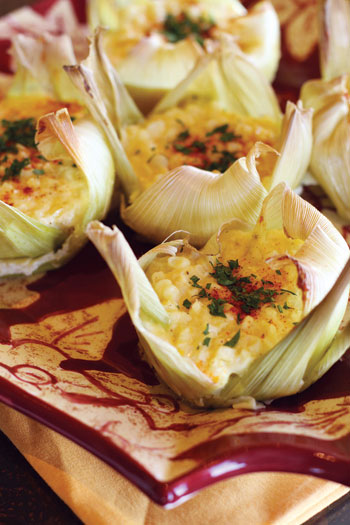 Roxanne, a local-produce distributor, brought giant bags of fruits and vegetables to share, including bright ears of Kula corn. Perfect, since everyone was excited to try Chef Pang’s corn pudding. Pang excels at artful presentation; in this recipe he cleverly incorporates the cornhusks as muffin tin liners. Individually wrapped in its own husk, each pudding arrives on the plate a present.
Roxanne, a local-produce distributor, brought giant bags of fruits and vegetables to share, including bright ears of Kula corn. Perfect, since everyone was excited to try Chef Pang’s corn pudding. Pang excels at artful presentation; in this recipe he cleverly incorporates the cornhusks as muffin tin liners. Individually wrapped in its own husk, each pudding arrives on the plate a present.
Roxanne patiently simmered the corn in a mixture of heavy cream, egg, and Parmesan cheese, not quite feeling satisfied with its thickness. (We had half the recommended amount of cream on hand, so we substituted with whole milk.) Still dubious, she lined the muffin tins with cornhusks and poured in the mix. Twenty minutes later, perfectly baked puddings emerged from the oven. Roxanne and Jodie dusted them with paprika and minced parsley for added color.
Results: Adorable and delicious. Almost rich enough to be a dessert, the puddings were a delightful, sweet complement to the meal. Fresh corn is critical in this recipe, and we were blessed with some of the island’s best. No one noticed the missing heavy cream—if anything, we could’ve reduced it further.
Namasu with Crab and Ogo
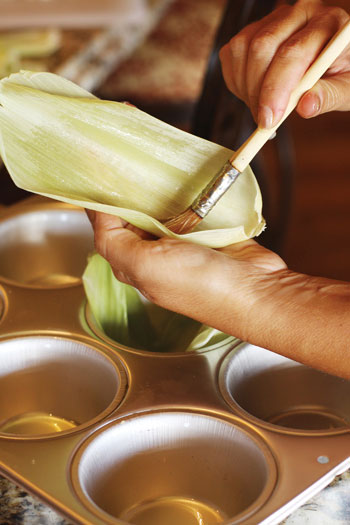 I love the cucumber salad at Japanese restaurants, and Pang’s version with king crab sounded lovely. Hana Farms’ incomparable cucumbers are small, emerald beauties that shrink up and absorb marinades—a perfect choice for this recipe. Preparation is a cinch, too: “wilt” the cucumbers in salt, combine the ingredients (mirin, vinegar, sugar, grated ginger, and seaweed) and chill.
I love the cucumber salad at Japanese restaurants, and Pang’s version with king crab sounded lovely. Hana Farms’ incomparable cucumbers are small, emerald beauties that shrink up and absorb marinades—a perfect choice for this recipe. Preparation is a cinch, too: “wilt” the cucumbers in salt, combine the ingredients (mirin, vinegar, sugar, grated ginger, and seaweed) and chill.
My go-to stops for seafood—Takamiya Market and Pukalani Foodland—both happened to be out of ogo (a crunchy, red seaweed) the day we needed it. Instead, Dania procured lipoa, a golden-brown seaweed completely different in texture and flavor. We decided to try it as a substitute and divvied up the crab to garnish each salad bowl.
Results: Colorful and elegant. The mirin-based marinade was a tad sweet, but the salty minerality of the lipoa added balance. Next time I make it, I’ll reduce the sugar and add a pinch more ginger.
Macadamia-Nut-Crusted Mahimahi with Olowalu Nui Tomato and Ginger
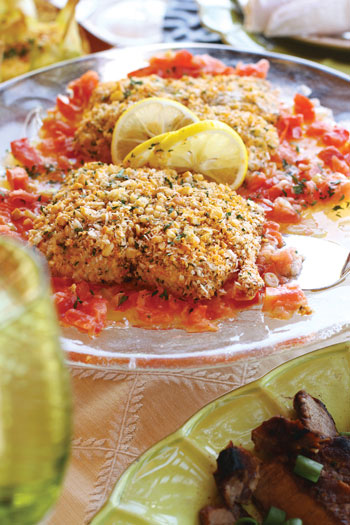 The cookbook’s “Ocean Treasures” and “Makai Catch” sections include recipes for all varieties of seafood found in Maui waters: lobster, squid, kumu (goatfish) ‘opihi (limpet), and even kupe‘e (sea snail). While locals will delight in the oven-dried akule (big-eyed scad), mainlanders might have difficulty finding this island specialty in their supermarkets. I opted to test macadamia-nut-crusted mahimahi. This popular dish is a standard at most fine restaurants on Maui; I was curious to see how Chef Pang’s version measured up.
The cookbook’s “Ocean Treasures” and “Makai Catch” sections include recipes for all varieties of seafood found in Maui waters: lobster, squid, kumu (goatfish) ‘opihi (limpet), and even kupe‘e (sea snail). While locals will delight in the oven-dried akule (big-eyed scad), mainlanders might have difficulty finding this island specialty in their supermarkets. I opted to test macadamia-nut-crusted mahimahi. This popular dish is a standard at most fine restaurants on Maui; I was curious to see how Chef Pang’s version measured up.
Dania diced tomatoes and I minced onions for the sauce, which included a dash of pickled ginger. Dania coated each filet with a crust of macadamia nuts, panko crumbs and parsley, drizzled them with butter, and popped them into the oven.
Results: Moist and buttery, but missing something. Perhaps a little more pickled ginger? Definitely more pepper. Dania suggested a quick pan-sear before baking the filets, to seal their flavor. Over all, the dish was a success, perfect for serving guests with mild palettes.
Banana Lumpia
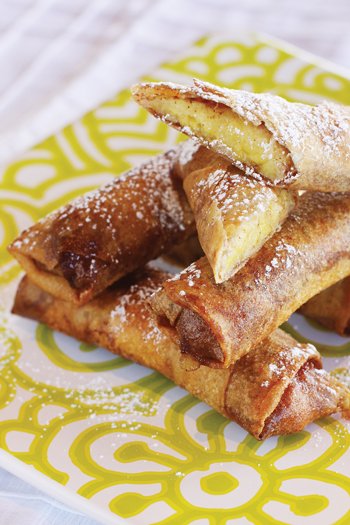 Who in Hawai‘i doesn’t love lumpia? Savory or sweet, this Filipino snack is a local staple. It’s just one of several plantation-inspired recipes included in the cookbook that evoke cultural traditions and invite readers to spend creative time with others. Chef Pang recommends assembling the family around the table to make double or triple batches of lumpia to freeze for later.
Who in Hawai‘i doesn’t love lumpia? Savory or sweet, this Filipino snack is a local staple. It’s just one of several plantation-inspired recipes included in the cookbook that evoke cultural traditions and invite readers to spend creative time with others. Chef Pang recommends assembling the family around the table to make double or triple batches of lumpia to freeze for later.
Following his advice, we sliced local apple bananas (courtesy of Roxanne and Kula Fields) lengthwise, coated them in brown sugar and cinnamon and folded each slice into its own pastry envelope. Dania dipped the wrapped morsels into a deep wok filled with vegetable oil. Chef Pang praises the versatile cooking vessel: “With a wok, dishes come together in a flash.”
Results: Irresistible. Dania barely finished slicing bananas before planning which fruits to try at home with her daughter. She wished she’d wrapped her lumpia more tightly, as the cinnamon escaped and dissipated in the oil. Nevertheless, the finished dessert was equal parts crisp and gooey goodness. Preparing the lumpia well ahead of time is smart, so that they can be fried just prior to eating—otherwise they lose their crispness.
Our cooking adventure wound to a close as the sun began its descent. We sat down to an amazing meal that we’d prepared together, filled with gratitude and camaraderie.
The inspiration for our gathering, What Maui Likes to Eat, proved to be a marvelous resource we each anticipate exploring further. For historic value alone, it’s a treasure; the many anecdotes and vintage photos dish out sweet nostalgia. Recipes run the gamut from simple to complex, with ingredients that are both easy to find and deliciously exotic. If you’re shopping for local-style recipes that truly capture the flavors of Maui, this is one present that belongs under the tree.
The icing on the cake? Pang has generously donated proceeds from the book to the Maui Culinary Academy. By buying it you’ll be supporting the education of future Maui cooks and, with luck, future cookbook authors.


